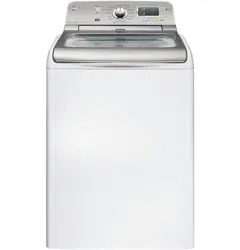Documents: Go to download!
- Owner's manual - (English, Spanish)
- Operating instructions
- Care and cleaning
- Troubleshooting Tips
Table of contents
USER MANUAL Washer
Operating instructions
Throughout this manual, features and appearance may vary from your model.
 |
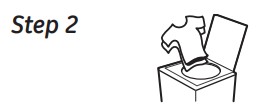 |
|
|
NOTE: Washer will not fill with lid open. |
 |
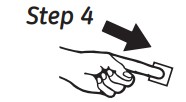 |
|
|
|
Controls
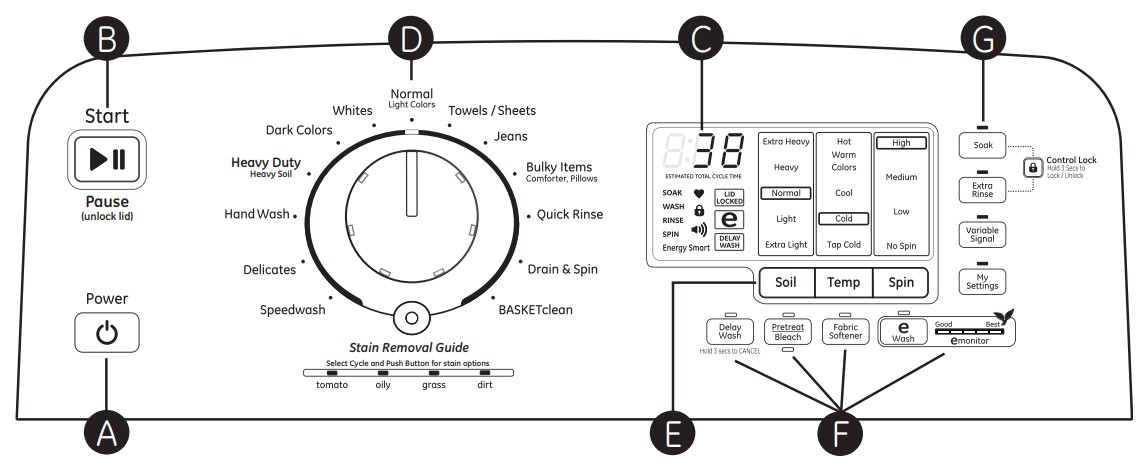
A. Power
Press to “wake up” the display. If the display is active, press to put the washer into idle mode. NOTE: Pressing POWER does not disconnect the appliance from the power supply
B. Start and Pause
Press Start to begin the cycle. NOTE: The lid must be closed for the washer to fill and the cycle to start. If the lid is open, “LID” will scroll across the display. If the lid is closed, the lid will lock, the detergent will be dispensed, and “FILL” will scroll across the display.
Pressing Start again will Pause the cycle and the Start indicator light will blink.
To continue the cycle, press Start again. If machine is paused more than 24 hours, the cycle will be cancelled. If water remains in the machine, select the Drain & Spin cycle to drain tub and spin water out of the washer tub.
C. Display and Status Lights
Display: The display shows the approximate time remaining until the end of the cycle
NOTE: The cycle time is affected by how long it takes the washer to fill. This depends on the water pressure in your home. The “smart” timer “learns” the amount of time it takes to fill your washer and adjusts the total time accordingly.
In addition, this display will, “scroll” the washer status:
- bALAnCINg Start of rebalancing cycle to redistribute clothes. Stops after rebalancing is complete.
- CyCLE PrEP Sensing dry load size prior to fill (normal).
- dELAY When Delay Wash is initiated. Replaced with estimated time when cycle starts.
- End End of current cycle.
- ES Washer in a delay start (4 hour maximum) awaiting lower energy rates (see the Energy Smart section)
- FILL For the first 45 seconds of a fill, the estimated end of cycle time is displayed. For the rest of the fill time, “FILL” is scrolled until the fill completes.
- H2O SUPPLY Can not sense water level (valves possibly turned off).
- LId Cycle stopped because lid is open. Close the lid.
- LOAd SenSE Sensing wet load size (normal).
- PAUSE Cycle paused because the Start/Pause button was pressed and the washer was set to Pause. Press Start button again to restart the cycle
Cycle status lights: Shows whether the washer is in the SOAK, WASH, RINSE or SPIN cycle
Feature status lights indicate (see sections F and G for more details):
 |
The My Settings feature is on for this cycle. |
 |
The washer is locked - will blink once if you press any button or turn the cycle knob. |
 |
The signal is on. See the Variable Signal description. |
 |
The Energy Smart feature is selected. See About Appliance Communication section. |
 |
The lid is locked. See the Control Lock description. |
 |
The eWash feature is selected. |
 |
A Delay Wash time is set. |
D. Wash Cycles-Cycle Selector Knob
The wash cycle controls the type of washing process. The Cycle Selector knob can be turned in either direction. Turning the knob after starting a cycle will stop the washer and change the cycle/options to the new selection. Press Start to begin the new cycle selection.
NOTE: When the knob is turned to another cycle, the tub light is turned on to assist in loading.
The chart below will help you match the wash cycle setting with your clothing.
| Speedwash | For small loads of lightly soiled items that are needed in a hurry. Provides light wash/rinse and short high speed spin. |
| Delicates | For lingerie and special-care fabrics with light to normal soil. Provides light wash and low speed spin. |
| HandWash | For items labeled hand washable with light soils. Provides an extra light wash and medium speed spin. |
| Heavy Duty/Heavy Soil | An above normal cycle for heavily soiled or stained clothes. A soak cycle is added and the agitate cycle is extended for extra cleaning. This more aggressive cycle should be used sparingly. |
| Dark Colors | For non-colorfast cottons and blends or items that are labeled cold wash. Provides normal wash and medium speed spin. |
| Whites | For heavy to lightly soiled whites, household linens, work and play clothes. Provides a heavy wash and a high speed spin. |
| Normal/Light Colors | For heavy to lightly soiled colorfast cottons, household linens, work and play clothes. This cycle provides the best overall cleaning and should be used for most everyday items. Provides normal wash and medium speed spin. |
| Towels/Sheets | Provides periods of agitation and soak tailored for washing towels and sheets. Provides normal wash and a high speed spin. |
| Jeans | For washing medium to lightly soiled jeans. Provides normal wash and an medium speed spin. (For heavily soiled work jeans, use Whites cycle.) |
| Bulky Items/Comforters, Pillows | For large coats, bed spreads, mattress covers, sleeping bags and similar large and bulky items. Large items such as blankets, comforters, jackets and small rugs. Provides a normal wash and an extra heavy spin. |
| Quick Rinse | Rinses and spins non-soiled items where a rinse only is desired. Provides an extra light wash and an extra high speed spin. Fabric Softener and Extra Rinse options are available with this cycle. |
| Drain & Spin | For draining the tub and spinning water out of the clothes. |
| BASKETclean |
Use for cleaning the basket of residue and odor. Recommended use of at least once per month. NOTE: Never load laundry while using BASKETclean. The laundry may become damaged or contaminated. See the Care and Cleaning section. |
 |
Stain Removal Guide The Stain Removal Guide feature allows you to indicate what stains are on the garments in your load. This feature can be used with any wash cycle. To use Stain Removal Guide:
Continue to press to select tomato stain, oily stain, grass stain or dirt stain. The indicator light will show the selected stain. To select a different stain, press the Stain Removal Guide button until desired stain to be removed is lit. To turn off Stain Removal Guide, press until the light on the button turns off. NOTE: The Soil and Temperature levels will be changed to match each stain type. Turning off Stain Removal Guide will return the settings to default. |
E. Settings
Individual settings for agitation (Soil), water temperature (Temp), and spin (Spin) can be set from the minimum (lowest in column) to maximum (highest in column). In general, the higher up the column, the more washer energy will be used.
NOTE: Higher Spin speeds typically reduce dryer time/energy usage (i.e. reduces total energy when using both a washer and a dryer).
F. Cycle Options
Delay Wash
When the Delay Wash button is repeatedly pressed, the delay time is set from 1 (01H) to 9 (09H) hours and back to clear (00H) hours. If you press and hold the Delay Wash button for 3 seconds, it will immediately reset.
Pretreat/Bleach
Set this option to add liquid pretreatment -OR- liquid bleach in the next load. Press once to indicate adding pretreatment (light on above button), twice to specify bleach (light on below button), three times to turn off (no light). Pretreatment or bleach will be added at the optimal time during the wash cycle (differs for pretreatment or bleach).
NOTE: Do NOT use pretreatment and bleach in the same load. If you forget to dispense (did not press button once or twice), you can flush out the dispenser by pouring water into the compartment and running a Quick Rinse cycle to remove from the tub.
Fabric Softener
Set this option to provide a deep rinse or when manually adding fabric softener to the rinse cycle. NOTE: This option is not allowed for some cycles. When allowed, it may change other settings (e.g. Spin may go to a higher setting) to maximize performance.
NOTE: Do not use fabric softener dispensing balls with this washer. They do not work correctly in high efficiency washers.
eWash
When the eWash button is pressed, the cycle changes to its most energy efficient settings and all of the eMonitor lights will light to indicate that the most efficient settings are on. If you change settings, the eWash light will go off and the number of eMonitor lights will decrease (or increase) to indicate decreased (or increased) energy efficiency settings.
G. Additional Options
Soak
This option begins with a brief agitation, soaks for a specified period of time, then moves through the rest of the cycle automatically. Repeated pressing of the Soak button will add 15 minutes, then 30 minutes and then return back to 0 soak minutes.
Extra Rinse
When you use extra detergent or bleach to clean heavily soiled clothes, use the Extra Rinse option to better remove additional residues.
NOTE: This option is not allowed for some cycles.
Control Lock
You can lock the controls to prevent any selections from being made. Or you can lock the controls after you have started a cycle. Children cannot accidentally start the washer by touching buttons with this option selected.
To lock the washer controls, press and hold both the Soak and Extra Rinse buttons for 3 seconds. The control lock icon will light up when it is on.
To unlock the washer controls, press and hold both the Soak and Extra Rinse buttons for 3 seconds.
NOTE: The Power button can still be used when the machine is locked.
Variable Signal
Use the Variable Signal button to change the volume of the end of cycle signal. Press the button until you reach the desired volume (high, medium, low) or off.
My Settings
As the cycle selector knob is turned, the Soil, Temp and Spin settings change to automatic pre-set default settings. If you desire a different setting, select the desired options or changes to cycle settings. Press and hold the My Settings button for 3 seconds, the washer will save these settings for that cycle and the status heart  and My Settings button will light when active. In the future, when you turn the selector knob to that cycle, your settings will be automatically recalled. To temporarily (i.e. for this load) return to the pre-set default settings, press the My Settings button for 1/2 second. The status heart
and My Settings button will light when active. In the future, when you turn the selector knob to that cycle, your settings will be automatically recalled. To temporarily (i.e. for this load) return to the pre-set default settings, press the My Settings button for 1/2 second. The status heart  and button lights will turn off and the options will change back to these defaults. To make these default settings permanent, hold the My Settings button again for 3 seconds to make them your preferred settings (the lights will turn back on). NOTE: My Settings includes Stain Removal Guide but NOT Delay Wash or Variable Signal.
and button lights will turn off and the options will change back to these defaults. To make these default settings permanent, hold the My Settings button again for 3 seconds to make them your preferred settings (the lights will turn back on). NOTE: My Settings includes Stain Removal Guide but NOT Delay Wash or Variable Signal.
About washer features.
Laundry Additives
All additives – detergent, fabric softener, and pretreatments (e.g. OxiClean®) are added in the front corners. Your option selections will determine when each additive is automatically dispensed at its optimal time in the wash or rinse cycle.

 DO NOT put detergent packets in dispenser compartments. Laundry detergent packets should only be added directly to the wash tub following the manufacturer’s directions.
DO NOT put detergent packets in dispenser compartments. Laundry detergent packets should only be added directly to the wash tub following the manufacturer’s directions.
Single Use Pretreatment or Liquid Bleach
To add either liquid pretreatment or liquid bleach to the next load, pour only one of them in the left rear compartment and press the Pretreat/Bleach button either once to light the pretreat light (above button) or twice to light the bleach light (below button). The liquid will be added at the optimal time (pretreatment - early or bleach – late) in the wash cycle.
Pretreatment option

- Check clothing care labels for special instructions.
- Measure liquid pretreatment carefully, following instructions on the bottle.
- Before starting the washer, pour measured amount of pretreatment directly into the compartment.
Bleach option

The water fill dilutes liquid chlorine bleach as the washer fills for the wash cycle.
1. Check clothing care labels for special instructions.
2. Measure liquid bleach carefully, following instructions on the bottle.
- Never pour undiluted liquid chlorine bleach directly onto clothes or into the wash basket.
- Do not pour powdered bleach into bleach compartment.
3. Before starting the washer, pour measured amount of bleach directly into bleach compartment. Avoid splashing or over-filling dispenser. If you prefer to use powdered bleach, add it into the wash basket with your detergent.
- Do not mix chlorine bleach with ammonia or acids such as vinegar and/or rust remover. Mixing can produce a toxic gas which may cause death.
Single Use Wash Detergent Dispenser
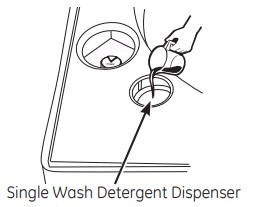 |
To manually add either powder or liquid detergent to the next wash cycle, pour it in the left front opening. Most detergent will immediately enter the tub. The washer will flush water through this opening just prior to the fill cycle to add any detergent that did not fall into the tub. |
 DO NOT put detergent packets in dispenser compartments. Laundry detergent packets should only be added directly to the wash tub following the manufacturer’s directions.
DO NOT put detergent packets in dispenser compartments. Laundry detergent packets should only be added directly to the wash tub following the manufacturer’s directions.
Single Use Softener
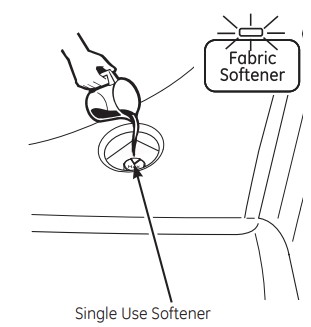 |
To add liquid fabric softener to the next load, press the Fabric Softener button and pour the softener into the right opening. The liquid will be added at the optimum time in the rinse cycle. NOTE: If using delay mode, add liquid softener to the dispenser and then fill the dispenser to the MAX fill level with water. |
 DO NOT put detergent packets in dispenser compartments. Laundry detergent packets should only be added directly to the wash tub following the manufacturer’s directions.
DO NOT put detergent packets in dispenser compartments. Laundry detergent packets should only be added directly to the wash tub following the manufacturer’s directions.
Care and cleaning
Cleaning the Interior of the Washer
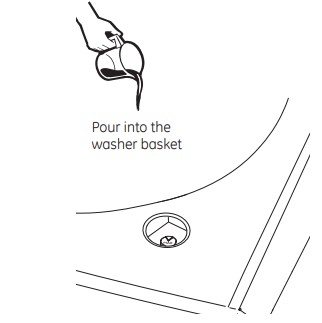 |
To clean the interior of the washer, select the BASKETclean feature on the control panel. This BASKETclean cycle should be performed, at a minimum, once per month. This cycle will use more water, in addition to bleach, to control the rate at which soils and detergents may accumulate in your washer. NOTE: Read the instructions below completely before starting the BASKETclean cycle. 1. Remove any garments or objects from the washer and ensure the washer basket is empty. 2. Open the washer lid and pour one cup or 250 ml of liquid bleach or other washing machine cleaner into the basket. 3. Close the lid and select the BASKETclean cycle. Push the Start button. 4. When the BASKETclean cycle is working, the display will show the estimated cycle time remaining. The cycle will complete in about 90 minutes. Do not interrupt the cycle. |
BASKETclean may be interrupted by pressing the Start pad in between cycles. A power outage in the house might also interrupt the cycle. When the power supply is back, the BASKETclean cycle resumes where it had stopped. When interrupted, be sure to run a complete BASKETclean cycle before using the washer. If the Power pad is pressed during BasketClean, the cycle will be lost.
IMPORTANT:
- Run BASKETclean with 1 Cup (250 ml) of bleach once a month.
- After the completion of a BASKETclean cycle, the interior of your washer may have a bleach smell.
- It is recommended to run a light color load after the BASKETclean cycle.
Troubleshooting Tips
| WATER | Possible Causes | What To Do |
|---|---|---|
| Short spray and delay after pushing the Start button | Lid was opened and closed between cycle selection and start |
|
| Water level seems low | This is normal |
|
| Banging sound during drain | Drain stand pipe is too low |
|
| Too many suds | Soft water |
|
| Too much detergent |
|
|
| Type of detergent |
|
|
| Water leaks | Type of detergent |
|
| Using too much detergent in washer |
|
|
| Fill hoses or drain hose is improperly connected |
|
|
| Household drain may be clogged |
|
|
| Drain hose rubs on wall |
|
|
| Constant water pressure to the fill hoses at the water source |
|
|
| Water temperature seems incorrect | Cooler water temperatures provide improved energy efficiency |
|
| Water supply is turned off or improperly connected |
|
|
| Water valve screens are stopped up |
|
|
| Cool/Cold Water when selecting Hot |
|
|
| House water heater is not set properly |
|
|
| Water pumped out before cycle is complete | Lid lifted or cycle was put in pause for over 8 hours |
|
| Water won’t drain | Drain hose is kinked or improperly connected |
|
| Washer pauses at the beginning of cycles | This is normal |
|
| Washer pauses during wash cycle | The Auto Soak Option was chosen |
|
| Washer pauses during spin cycle | This is normal |
|
| OPERATION | Possible Causes | What To Do |
|---|---|---|
| Washer does not fill when lid is open | This is normal |
|
| Washer won’t operate | Washer is unplugged |
|
| Water supply is turned off |
|
|
| Controls are not set properly |
|
|
| Lid is open- safety feature prevents agitation and spinning when lid is up |
|
|
| Circuit breaker/fuse is tripped/blown |
|
|
| Electronics need to be reset |
|
|
| Start was not pressed |
|
|
| Lid magnet missing |
|
|
| Dispenser not dispensing properly | Laundry detergent packet placed in dispenser |
|
| Unexplained time and/or settings changes | Changing options |
|
| Movement inside machine when shut off | Shifting mechanism is disengaging the motor |
|
| Basket seems loose | Basket moves or rotates freely |
|
| PERFORMANCE | Possible Causes | What To Do |
|---|---|---|
| Clothes too wet | Incorrect cycle selected. |
|
| Wash load out of balance |
|
|
| Colored spots | Incorrect use of fabric softener |
|
| Dye transfer |
|
|
| Grayed or yellowed clothes | Detergent amount |
|
| Hard water |
|
|
| Water is not hot enough |
|
|
| Washer is overloaded |
|
|
| Dye transfer |
|
|
| Lint or residue on clothes | Clothes are air or line dried |
|
| Incorrect sorting |
|
|
| Washing too long |
|
|
| Detergent not dissolving |
|
|
| Overloading |
|
|
| Incorrect use of fabric softener |
|
|
| Pilling | Result of normal wear on poly-cotton blends and fuzzy fabrics |
|
| Snags, holes, tears, rips or excessive wear | Pins, snaps, hooks, sharp buttons, belt buckles, zippers and sharp objects left in pockets |
|
| Undiluted chlorine bleach |
|
|
| Chemicals like hair bleach or dye, permanent wave solution |
|
|
| Wrinkling | Incorrect wash and dry cycles |
|
| Improper sorting |
|
|
| Overloading or incorrect water level |
|
|
| Repeated washing in water that is too hot |
|
|
| Bleach left in dispenser | Didn’t start or finish cycle after adding bleach |
|
| SOUNDS | Possible Causes | Reason |
|---|---|---|
| Washer seems quite | This is normal |
|
| “Metallic clicking” | Shifter mechanism is engaging or disengaging |
|
| Back and forth “swoosh” or light “clicking” sound during agitate | Electric motor reversing direction |
|
| Quick short agitation sounds at end of agitate | Clothing redistribution |
|
| “Click” when water stops filling | Relay switch |
|
| “Clicking” behind Control Panel during fill | Automatic Temperature Control Valve |
|
| Water flow changes during fill | Automatic Temperature Control Valve |
|
| Motor “whining up” or “coasting down” in spin | Motor ramping up/down during spin cycle |
|
| “Humming” | Water drain pump |
|
| “Gurgling” | Water drain pump |
|
| Water “swishing” | This is normal |
|
| Washer is noisy | Washer is uneven |
|
See other models: GRDN510GM1WS WCVH6400J0WW GTH18ISXARSS AZ35H12E3DM1 GSE26HMECHES
 detergents in all Energy Star-rated washers.
detergents in all Energy Star-rated washers.